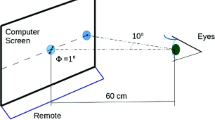Summary
Saslow (1967) and Fischer and Ramsperger (1984) found that saccadic reaction time (SRT) depends on the interval between the fixation point offset and the target onset. Using a continuously visible fixation point, we asked whether a similar function would be obtained if subjects attended to a peripherally viewed point extinguished at variable intervals before or after the target onset. The interval was varied between -500ms (i.e., attention stimulus offset after saccade target onset = overlap trials) and 500ms (i.e., attention stimulus offset before saccade target onset = gap trials). The results show a constant mean SRT of about 240 ms for overlap trials, and a U-shaped function with a minimum of 140 ms, at a gap duration of 200 ms, for gap trials. These findings suggest that saccadic latencies do not depend on the cessation of fixation per se, but rather on the disengagement of attention from any location in the visual field. The time required for subjects to disengage their attention is approximately 100 ms. This disengaged state of attention — during which short latency (express) saccades can be made — can be sustained only for a gap duration of 300 ms. At longer gap durations mean SRTs increase again.
Similar content being viewed by others
References
Bushnell MC, Goldberg ME, Robinson DL (1981) Behavioral enhancement of visual responses in monkey cerebral cortex. 1. Modulation in posterior parietal cortex related to selective visual attention. J Neurophysiol 46: 755–772
Engel FE (1971) Visual conspicuity, directed attention and retinal locus. Vision Res 11: 563–576
Fischer B (1987) The preparation of visually guided saccades. Rev Physiol Biochem Pharmacol 106: 2–35
Fischer B, Boch R (1981) Enhanced activation of neurons in prelunate cortex before visually guided saccades of trained rhesus monkeys. Exp Brain Res 44: 129–137
Fischer B, Boch R (1983) Saccadic eye movements after extremely short reaction times in the monkey. Brain Res 260: 21–26
Fischer B, Breitmeyer B (1987) Mechanisms of visual attention revealed by saccadic eye movements. Neuropsychology 25: 73–83
Fischer B, Ramsperger E (1984) Human express-saccades: extremely short reaction times of goal directed eye movements. Exp Brain Res 57: 191–195
Fischer B, Ramsperger E (1986) Human express-saccades: effects of daily practice and randomization. Exp Brain Res 64: 569–578
Gauthier GM, Volle M (1975) Two dimensional eye movement monitor for clinical laboratory recordings. Electroencephalogr Clin Neurophysiol 39: 285–291
Goldberg ME, Bruce CJ (1985) Cerebral cortical activity associated with the orientation of visual attention in the rhesus monkey. Vision Res 25: 471–481
Goldberg ME, Wurtz RH (1972) Activity of superior colliculus in behaving monkey. J Neurophysiol 35: 542–596
Mayfrank L, Mobashery M, Kimmig H, Fischer B (1986) The role of fixation and visual attention on the occurrence of express saccades in man. Eur Arch Psychiatr Neurol Sci 235: 276–281
Posner MI (1980) Orienting of attention. Q J Exp Psychol 32: 3–25
Remington RW (1980) Attention and saccadic eye movements. J Exp Psychol Hum Percept Perform 6: 726–744
Remington RW, Pierce L (1984) Moving attention: evidence for time-invariant shifts of visual selective attention. Percept Psychophys 35: 393–399
Saslow MG (1967) Effects of components of displacement-steps stimuli upon latency of saccadic eye movements. J Opt Soc Am 57: 1024–1029
Schiller PH, Sandell JH, Maunsell JHR (1987) The effect of frontal eye field and superior colliculus lesions on saccadic latencies in the Rhesus monkey. J Neurophysiol 57: 1033–1049
Shulman GL, Remington RW, McLean JP (1979) Moving attention through visual space. J Exp Psychol Human Percept Perform 5: 522–526
Shulman GL, Wilson J, Sheehy JB (1985) Spatial determinants of the distribution of attention. Percept Psychophys 37: 59–65
Author information
Authors and Affiliations
Rights and permissions
About this article
Cite this article
Braun, D., Breitmeyer, B.G. Relationship between directed visual attention and saccadic reaction times. Exp Brain Res 73, 546–552 (1988). https://doi.org/10.1007/BF00406613
Received:
Accepted:
Issue Date:
DOI: https://doi.org/10.1007/BF00406613




